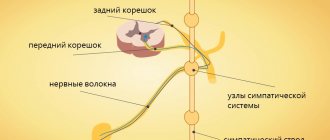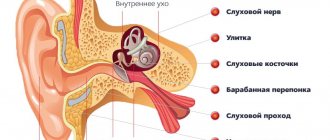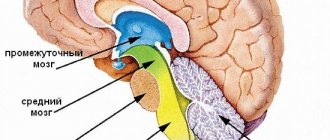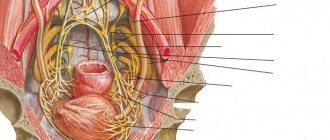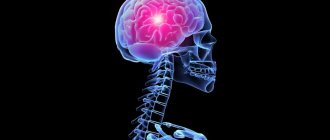In this article you will learn what the sympathetic and parasympathetic nervous systems are. A component of the human system is the autonomic system, the most important function of which will be to ensure the vital functions of absolutely all organs. Consists of the sympathetic and parasympathetic divisions of the nervous system, aimed at providing the opposite effect on every human organ. If we talk about the vegetative system as a whole, it is the only one that is quite complex, but generally autonomous, not subject to human will. The sympathetic and parasympathetic nervous system, its anatomy, is a complex system of nerve nuclei connected by fibers and delivering impulses from stimuli to the central nervous system.
Functional significance of the sympathetic and parasympathetic nervous system
The autonomic nervous system is divided into two sections: peripheral and central. The central department is responsible for monitoring the functioning of internal organs and manages the work of absolutely all organs. The central department works around the clock, without breaks.
The peripheral division is divided into two subdivisions: the parasympathetic and sympathetic nervous system. The nervous system of every person is completely structured.
Both the sympathetic division and the parasympathetic nervous system function simultaneously. Their performance will largely depend on the needs of the body at a particular time.
Due to the multidirectionality and impact on the organs of the centers of the parasympathetic and sympathetic parts of the nervous system, absolutely all healthy people can adapt to different conditions and environmental factors, for example, in the dark, the eyes will be more concentrated in order to see and distinguish objects around a person. In cold weather, the body tries to produce more heat than in normal climatic conditions. On a hot day, the human body cools the skin through increased sweating. It is these processes and many others that are controlled by the peripheral part of the autonomic nervous system, which performs two main functions:
- Ensuring homeostasis (the performance of each organ is constantly maintained at the same level).
- Creation of full-fledged mental and physiological functioning of the human body.
Increased physical activity forces the autonomic nervous system to control the pressure in the circulatory system to prevent its drop or excessive increase. The same applies to the work of the heart, which begins to work more actively in order to ensure optimal blood circulation in the body. During periods of passivity and rest, heart contractions decrease, sending a message to the autonomic system.
How does the sympathetic nervous system differ from the parasympathetic? First of all, by the “options” carried out and the impact on the activities of individual bodies.
The central department of the autonomic parasympathetic nervous system is completely independent in its work, literally scattered throughout the brain, and therefore actively participates in all biological processes of the human body.
The central section is divided into several structures - segmental and suprasegmental. The latter combines several more subdivisions, including the hypothalamus.
What is the hypothalamus?
The lower part of the human brain is called the hypothalamus. The shape and structure do not have clearly defined boundaries, smoothly transitioning into the tissues of other brain regions.
Consisting of many small cell nuclear groups (to date, only thirty-two nuclear pairs have been studied), the hypothalamus generates impulses that reach other areas of the brain along special pathways. The formed nerve impulses work to control the respiratory, digestive, and circulatory systems. It is from the uninterrupted operation of the hypothalamus that the body regulates the process of maintaining water-salt balance, normalizes body temperature, and during the hot season and with increased physical activity, active sweating occurs in order to cool the skin and prevent overheating.
In addition to transmitting nerve impulses, the hypothalamus produces releasing factors - hormonal substances. Thanks to their production in the postpartum period, the woman “starts” the production of milk in the glands; childbirth, due to hormonal changes, ensures full contractile movements of the uterus to move the fetus along the birth canal, etc.
The hypothalamus performs its function only due to the close relationship of this part of the brain with the pituitary gland, which is the main organ of the endocrine system and continuously links together the work of the two systems.
The hypothalamus is divided into several zones:
Trophotropic
Located in the near zones of the hypothalamus and maintaining a constant internal environment, it normalizes the functioning of the heart and blood vessels during the rest period, and removes decay products of human activity. The main effect occurs through the parasympathetic department. When this zone is stimulated, the production of sweat and saliva increases, the heart rate slows down, blood pressure decreases, etc.
Ergotropic
Responsible for the ability of the human body, regardless of age, to adapt to changing environmental conditions, carrying out adaptation of the body and implemented through the sympathetic department.
The result of the functioning of the ergotropic system and the influence of the parasympathetic nervous system on cardiac activity: blood pressure, blood glucose levels, increased heart rate, and respiratory function increase. The ergotropic zone is located in the posterior part of the hypothalamus.
The parasympathetic division of the autonomic nervous system controls:
- lacrimation;
- pupil enlargement/decrease;
- production of saliva.
It also affects the functioning of internal organs (bronchopulmonary system, cardiac muscle, gastrointestinal tract, etc.).
How is it formed
The initiation begins in the ectoderm. The main inclusions are formed in the spine, hypothalamus, and brain stem. Peripheral inclusions originate in the lateral vertebrae of the spinal cord. From this moment on, connecting branches are formed that approach the nodes of the sympathetic system. Already from the third week of embryonic growth, neural trunks and nodes are formed from neuroblasts, which serve as a prerequisite for the subsequent formation of internal organs. Initially, the trunks are formed in the intestinal walls, then in the heart tube.
The trunks of the sympathetic system consist of the following nodes - 3 cervical, 12 thoracic, 5 abdominal and 4 pelvic. The plexuses of the heart and carotid artery are formed from the cells of the cervical ganglion. The thoracic nodes trigger the work of the lungs, blood vessels, bronchi, pancreas, and the lumbar nodes are involved in the transmission of nervous reactions to the bladder and male and female genital organs.
The entire process of formation of the sympathetic system takes about four to five months of embryonic growth and fetal development.
How do the sympathetic and parasympathetic nervous systems work? Features and main differences
The sympathetic and parasympathetic nervous system, its structure is unique and individual for each person. The activity of the departments will largely depend on age and health status. The neural impulse moves in a strictly specified direction. This movement is based on a reflex arc in the form of a closed chain of neurons. The work of the departments can be seen using a clear example: receptors on the skin detect an irritant in the form of cold, transmit the received data along nerve fibers to the central nervous system, where it is analyzed and evaluated. After which it is these two main departments that make the decision on the impact on the emerging stimulus. In our example, this is a person’s need to warm himself so as not to get too cold and protect himself from the cold. The impulse is transmitted along the nerve endings to the central section, and from there to the peripheral, where the impact occurs as a result of the stimulus - the skin becomes “goosey”, active muscle contraction occurs, aimed at warming the whole body under the influence of cold.
What is the parasympathetic nervous system responsible for?
The human body tends to adapt to stimuli that surround us at almost every step. Moreover, adaptability in each specific case will look different and have the opposite character. For example, the summer heat would have an adverse effect on the human body, if not for its ability to cool down due to increased sweating; in the cold season, sweat production stops and the mechanism of maximum heat retention in the cells is activated. Therefore, the functions of the sympathetic and parasympathetic nervous systems are different and opposite, aimed at the body’s ability to turn on or off a certain “option” at a certain moment.
Differences between the sympathetic and parasympathetic nervous systems.
The sympathetic and parasympathetic nervous system, as a result of its work, activates different “effects”.
Sympathetic:
– dilation of the pupils when exposed to a stimulus (bright light or darkness), protrusion of the eyes;
– narrowing of blood vessels;
– decreased secretion of saliva, which acquires increased viscosity and thickness;
– increased frequency of contractions of the heart muscle;
– noticeable increase in blood pressure;
– rapid breathing;
– dilatation of the bronchi with a simultaneous decrease in excretory function;
– deterioration of intestinal function;
– spontaneous ejaculation or its stimulation;
- "goose pimples".
Parasympathetic
The parasympathetic nervous system performs functions, consider them in the table:
| Eyes | Constriction of the pupil |
| Excretory function | Increased salivation. |
| Heart | Reducing blood pressure and reducing the number of heart beats. |
| Bronchopulmonary system | The amount of secretion in the bronchi increases, breathing becomes calm and measured, the bronchi narrow |
| Intestines | Peristalsis increases, spasmodic pain may appear |
| Digestive system | There is a noticeable increase in secretion production in the digestive gland |
| Genitourinary system | Spontaneously occurring stimulation of the clitoris in women and the onset of erection in men |
In general terms, the activity of the parasympathetic part of the autonomic nervous system leads to a general “excitation” of human organs and vital systems, intensifying their work due to the influence of irritating factors.
As can be seen from the data in the table, the sympathetic and parasympathetic nervous systems differ from each other in terms of the “options” they perform. However, despite all their differences, the autonomic nervous system - sympathetic and parasympathetic - are closely interconnected. However, some functions of the human body are subject to the influence of only the sympathetic department and vice versa. For example, only the sympathetic department is responsible for the work of blood vessels, glands that reproduce sweat, and the adrenal glands, while the parasympathetic department of the nervous system has no effect.
Prevention
The best treatment for any disease is, of course, prevention. To prevent functional failures in the innervation of a particular organ, experts recommend that people follow the basic principles of a healthy lifestyle:
- give up bad habits – consumption of tobacco and alcohol products;
- get a good night's sleep - at least 8-9 hours of sleep in a ventilated, darkened, quiet room;
- adjust the diet - the predominance of vegetables, various fruits, herbs, cereals;
- compliance with the water regime - taking at least 1.5–2 liters of purified water, juices, fruit drinks, compotes, so that toxins and waste are removed from the tissues;
- daily activity - long walks, visiting the pool, gym, mastering yoga, Pilates.
A person who carefully monitors his health and visits a doctor for an annual medical examination will have calm nerves at any level. Therefore, they know about such problems as sweating, tachycardia, shortness of breath, high blood pressure only by hearsay, from their relatives.
The parasympathetic nervous system increases the tone of some organs, but decreases others.
In a person who has no health problems, does not suffer from nervous breakdowns, or anorexia, the parasympathetic and sympathetic nervous systems, despite their differences, work on the principle of balance. Normally, there is a slight predominance of one of the systems with a certain effect on the body.
The predominant activity of the parasympathetic part of the autonomic nervous system is called vagotonia, and the sympathetic part is called sympathicotonia.
Due to age-related changes occurring in the human body, the role of the sympathetic and parasympathetic nervous system can change noticeably, reducing the performance of their functions.
Let’s say that in adolescence, the activity of all organs and systems is significantly increased than in senility. The functional significance of the sympathetic and parasympathetic nervous systems is different. For example, the activity of the sympathetic system is expressed by shine in the eyes, enlarged pupils, increased blood pressure, and a high probability of difficulty during bowel movements.
Ciliary node (ganglion ciliare)
Flat, about 2 mm long and thick, located near the superior orbital fissure in the thickness of the fatty tissue at the lateral semicircle of the optic nerve. This node is formed by a cluster of cell bodies of second neurons of the parasympathetic part of the autonomic nervous system. Preganglionic parasympathetic fibers that come to this node as part of the oculomotor nerve end in synapses on the cells of the ciliary ganglion. Postganglionic nerve fibers, consisting of three to five short ciliary nerves, emerge from the anterior part of the ciliary ganglion, go to the back of the eyeball and penetrate it. These fibers innervate the ciliary muscle and the pupillary sphincter. Fibers that conduct general sensitivity (branches of the nasociliary nerve) transit through the ciliary ganglion, forming a long (sensitive) root of the ciliary ganglion. Sympathetic postganglionic fibers (from the internal carotid plexus) also transit through the node.
- The parasympathetic part of the facial nerve consists of the superior salivary nucleus, pterygopalatine, submandibular, hypoglossal nodes and parasympathetic nerve fibers. The axons of the cells of the superior salivary nucleus, which lies in the tegmentum of the pons, in the form of preganglionic parasympathetic fibers pass as part of the facial (intermediate) nerve. In the area of the genu of the facial nerve, part of the parasympathetic fibers is separated in the form of the large stony nerve (n. petrosus major) and exits the facial canal. The greater petrosal nerve lies in the groove of the same name in the pyramid of the temporal bone, then pierces the fibrous cartilage that fills the torn hole at the base of the skull, and enters the pterygoid canal. In this canal, the greater petrosal nerve, together with the sympathetic deep petrosal nerve, forms the nerve of the pterygoid canal, which exits into the pterygopalatine fossa and goes to the pterygopalatine ganglion.
Important Work program of a speech therapist for children with speech and language development disorders (SDD) 5-6 years old; methodological development in speech therapy (senior group) on the topic

